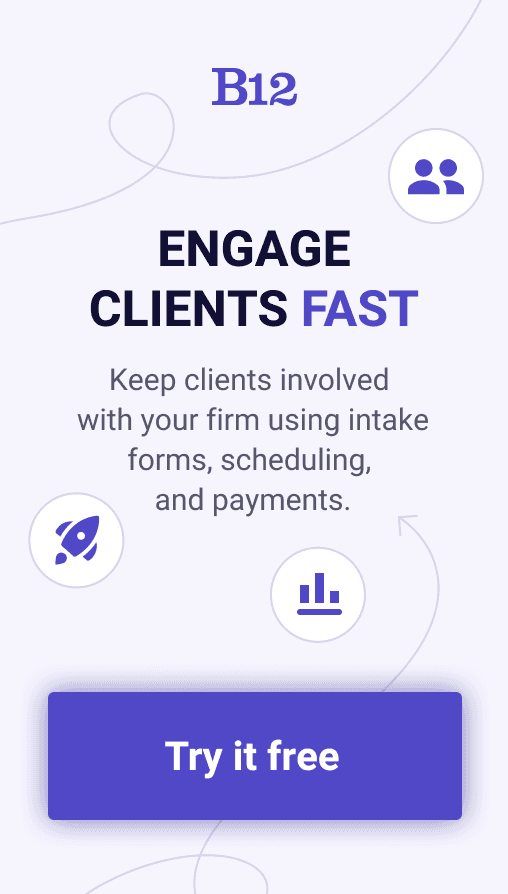Build an AI website in 60 seconds
AI generates your personalized website instantly with built-in scheduling, payments, email marketing, and more.
Start for free
How to write a digital contract for your business

The last couple of years have seen nearly every business business undergo a digital transformation. Marketing teams got advanced analytics; sales teams got customer relationship management systems (CRM); procurement departments got enterprise-grade solutions — and everyone’s embracing AI. Communication and collaboration among teams have also never been more streamlined.
As a result, businesses cover more ground at an accelerated pace, which is a good thing in more ways than one. So why haven’t contracts experienced their own fair share of the paperless revolution? Sure, there are more effective and efficient ways of sending and receiving contracts, but many businesses and professionals still favor the paper route in terms of the contract itself.
This means, for the most part, contract creation and signing are still disjointed and time-consuming, which can cost businesses that need agility now more than ever in today’s touch-free age. In this article, we’ll cover how to set up and send online contracts, the benefits of doing so, and the best digital contract tools to try.
Contracts are not so easy to digitize
Contracts were left behind in the digital transformation sweeping through business operations and management for a number of reasons, including:
- Contracts widely vary — Yeah, you could create and save templates for your usual contracts and service agreements, but they will still require a certain level of personalization for all the signers. The problem is that contracts often have tons of variations. It can be hard to develop a robust contract management software that can capture all those variations and nuances within a single system.
- Contracts are multiplayer — Contracts are the end result of complex collaboration, usually among multiple parties. Even if you created a digital contract on one platform, the person you’re sending it to might not be using the same tool. They then need to sign up on that platform before accessing the document and append their electronic signature (e-signature or e-sign). This can actually make the process more time-consuming and defeat the idea behind going for an electronic contract in the first place.
- Contracts are often complex— Some contracts are so intricate that we need legal professionals to scrutinize them and break them down into pieces we can understand. A digital contract may be easier to make, but that doesn’t make it easier or faster to interpret. If humans need specialized interpretation, how then can a piece of software fare better in interpreting an electronic contract?
In any case, digitization remains a strategic priority among business owners regardless of industry or size.
That’s why any good digital contract management solution can address these challenges head-on and streamline the contract lifecycle management process from start to finish.
But before we get too ahead of ourselves, let’s take a closer look at digital contracts and how they differ from traditional paper documents.
What is a digital contract?
It’s simply a contract that is created and stored online, digitally. With a digital or electronic contract, the entire contract management process can be done online. This means everything from contract creation to contract approval can all be completed without a single pen or paper, even to the contract signing.
A contract exists when the involved parties agree on a mutually beneficial exchange of value. An example is a contract you draw up on your computer and email to an independent contractor. They then email back the electronic documents duly signed with an e-signature indicating their acceptance.
Another example of a digital contract is the “click to agree” terms that usually follow after downloading software or signing up on a platform. By clicking the “I agree” button on the page, you’re indicating your acceptance and, therefore, binding yourself to the terms of the contract.
Buying something online is also a form of an electronic contract. Even without signing anything, you’re agreeing to pay a certain amount to the seller in exchange for the product or service.
Digital contracts have led to the rise of electronic signatures
An electronic signature is an electronic file or symbol, such as a photograph of your regular handwritten signature or a typed name, that you can use to sign documents online in real-time easily. These online signatures are integral to setting up a digital contract management system for your business.
People looking for a more secure form of eSignatures can always turn to digital signatures. Unlike regular e-signs, a digital signature includes cryptographic-level security that authenticates the signer and ensures that only the right people can access and edit the document.
In any case, if you want to digitize your contract management system, you’ll need to have an electronic signature saved on your device to make the contract signing process smoother.
Related: Step-by-step guide on how to create an electronic signature
How are digital contracts different from traditional paper contracts?
There are many differences worth noting, including:
Contract timeline
The time it takes to draft a traditional contract is usually longer than putting together a digital contract. Before, the entire contract lifecycle management process relied on one party manually drafting the new contract, sending the documents, or arranging a meeting with the other party to discuss the terms and then sign it.
During contract negotiation, the documents must be sent back and forth, or multiple meetings between both parties must be scheduled. This process is time-consuming and can easily be bogged down further by current issues such as travel restrictions and physical distancing structures.
Digital or online contracts are not subject to such time-wasting limitations. All parties can access the same document from their computers or mobile devices. The contract negotiation can occur via a simple video call, and the contract signing can be done in just a few clicks.
Contract costs
Going paperless through digital contract management systems will help slash several costs, including those associated with printing and postage. Plus, you also save on labor costs since digital contracts can be easily put together compared to their paper versions. In addition, this allows for a more streamlined workflow across the board.
Error potential
Both paper and digital contracts are prone to human errors. The difference here is that digital contracts are quicker to fix since the corrections can be made directly without having to print out a new copy each time a change is made.
Also, for digital contracts, especially those already stored as templates, the software automatically fills out much of the important contract data, such as the signer’s names and contact information. This automation means there’s a lower chance for errors.
Are digital contracts legally binding?
They sure are! Under the Federal legislation enacted in 2000 known as the Electronic Signatures in Global and National Commerce Act (ESIGN), electronic contracts and e-signatures are legally binding and enforceable, just like traditional contracts and signatures.
Most U.S. states have also adopted the Uniform Electronic Transactions Act (UETA), which gives legal backing to electronic contracts and signatures just like the ESIGN federal law. That means when you prepare a digital contract, you can rest easy knowing that it is legally valid and enforceable under both federal and state laws.
Are there limitations to digital contracts?
There are certain limitations under ESIGN. In other words, not all contracts can be created or signed electronically. These include:
- Wills, codicils, and testamentary trusts
- Legal documents that concern family law matters, such as divorce and adoption
- Cancellation or termination notices of utility services
- Court documents such as pleadings, motions, and court orders
- Cancellation or termination notices of life or health insurance benefits
- Eviction, foreclosure, and repossession notices
- Notices for product recall, especially where they concern health or safety
- Legal documents that must be presented when transporting hazardous materials
Creating a digital contract for your small business
So you want to switch to using electronic contracts for your small business. This entails setting up an electronic contract management system. At its most basic, digital contract management revolves around four main functionalities:
- Storage
- Tracking
- Searchability
- Reporting
These functionalities are what makes a digital contract viable for business use. After all, nailing down document management is often the biggest challenge for most organizations. A good contract management system securely stores all your documents and easily retrieves them using a simple search function. It should also allow you to quickly input contract data when creating new contracts.
How do you create a new digital contract?
The contract creation process itself is pretty straightforward. Just create the document on your computer as you would a traditional paper contract and make sure it has an e-signing functionality, then send it to the signer.
There are several contract management software available today that allow you to get all these done without leaving the platform. The most common include Adobe Acrobat, Docusign, and HelloSign. These programs are usually free to use or at least offer free trials so you can test them out for yourself and decide which one to use for your small business.
If you don’t want to use a dedicated contract management software, you could always use everyday office tools like Microsoft Word or Excel and Google Docs. These programs are beginner-friendly and allow for easier editing.
In any case, the important thing is that you are abiding by the requirements outlined by ESIGN and UETA for the creation and signing of digital contracts. In other words, you must follow these regulations if you want your digital contract to be legally valid and enforceable:
- Obtain consent from signers — The signer(s) must indicate their consent to using a digital contract before asking them to sign one. This consent can be obtained by agreeing in an email or simply included a caveat that e-signing the digital contract demonstrates their explicit agreement.
- Signers must fully understand what their e-signature on the digital document means — All parties should have a clear indication of what they’re signing. More importantly, they should understand that signing the digital contract means agreeing to be bound by its terms, the same way it would with an ink-and-paper contract.
- Let signers know that they can withdraw their prior consent — You need to inform the signers that they can withdraw their consent to using digital contracts or e-signatures at any time. Should they choose to exercise this right, you also need to provide them with a clear step-by-step process of how to go about withdrawing their consent.
- Give signers other options — Electronic contracts promote paperless transactions and a simpler approval process. However, some businesses and consumers may still prefer to use paper to create and sign a contract. That’s why it’s essential not to limit the signers to only the e-signature process.
- Keep copies of all documents — This is just sound document management practice. Save all copies of contracts you’ve created or sent out, whether in electronic or paper form. More importantly, make sure the other party can access these copies should the need arise.
To ensure that you’re in compliance with federal and state laws regulating digital contracts for small businesses, be sure to consult a qualified attorney. They can review your electronic practices and provide professional advice on disclosures and other important information.
Reasons to switch to digital contracts
Electronic signatures are a transformative leap forward. They're safer, more cost-effective, and dramatically faster than traditional signing methods. Embracing them is a smart move for any business looking to streamline its contract management process with confidence and efficiency.
Accelerated turnaround time
Imagine the speed of eSignatures as the digital equivalent of emails versus traditional snail mail. They revolutionize the signing process, enabling completion in a flash, no matter the geographical location of the involved parties.
With electronic signing, the cumbersome need to physically transport contracts to stakeholders is eliminated. There's no printing required – you can seamlessly transition from drafting to signing your contract in a digital environment. This efficiency is not just a time-saver; it's a game-changer in contract management.
Enhanced security
Contrary to initial apprehensions about eSignatures, they offer superior security compared to traditional methods. Paper documents are surprisingly vulnerable to tampering – they can be altered, scanned, reprinted, or even copied with ease.
Electronic signatures, however, provide each party with a secure, immutable copy of the document. Once signed, these documents are virtually tamper-proof. Advanced contract management software further fortifies this security by detecting the slightest alterations in documents, ensuring the integrity of your contracts.
Reduced costs
The cost-saving benefits of eSignatures extend beyond just eliminating the need for paper, ink, and postage. They significantly reduce the likelihood of human error, which, at its worst, can be not only time-consuming but also financially draining and hurt client relationships.
The automated nature of electronic signatures mitigates these errors, offering alerts for record-keeping or compliance issues. Moreover, their enhanced security translates into potential savings on legal fees, as electronically signed contracts are more robust against disputes.
How to sign a contract online
First, you need an eSignature and digital contract solution. Selecting the best digital contract tool largely depends on your specific needs, such as the volume of documents you handle, the nature of your team or business, and any specific features you might require.
- DocuSign: Ideal for businesses with a high volume of documents to sign. It's a robust, widely recognized platform with a range of features that cater to various business needs. If your business frequently deals with a large number of contracts, DocuSign is a reliable choice.
- Dropbox Sign: This is a great option if your business heavily relies on cloud storage, especially Dropbox. Its integration with Dropbox makes managing and signing documents very convenient. It's suitable for businesses that prioritize streamlined cloud storage integration.
- B12 Contracts and eSignatures: This one’s built into your professional website, so you can centralize your contacts, documents, invoice and payment history, appointment history, and more. It’s an easy-to-use, streamlined solution that’s scalable as your business changes and grows.
- eSignatures.io: This pay-as-you-go option is excellent for businesses or individuals who need a flexible, cost-effective solution without the commitment of a monthly subscription. It's particularly useful for those with fluctuating signing needs.
- signNow: This is a good middle ground for small teams. It offers more features than the basic free tools but is generally more affordable and user-friendly than some of the larger enterprise-focused platforms.
- PandaDoc: Known for its user-friendly interface and comprehensive feature set, including document automation, eSignatures, and data analysis. It's particularly beneficial for sales teams.
- Adobe Sign: Part of the Adobe Document Cloud, Adobe Sign is a powerful tool for businesses needing integration with other Adobe products or more advanced features.
Once you’ve chosen a digital contract solution, the process to set up and send is pretty simple.
Upload your contract: Next, effortlessly upload the contract you need to be signed. You can do this directly from your computer or conveniently access it from a file-sharing platform such as Box, Dropbox, Google Drive, or OneDrive. This step bridges the gap between your documents and their digital transformation.
Enter signer details: Now, input the names and email addresses of the individuals who need to sign your contract. This simple action sets the stage for involving all relevant parties in the signing process.
Indicate where to sign: Place “Sign” tags in the specific areas of the contract where signatures are required. This clear guidance ensures your clients know exactly where to sign. Depending on your tool, this may be done automatically or need very little editing. Once you've done this, hit the 'Send' button. This final step propels your contract into the signing workflow, bringing you closer to a completed agreement.
By following these steps, you're not just simplifying the signing process; you're embracing efficiency and modernizing how you handle contracts.
The bottom line
A big part of implementing digital transformation in your business is centered around digital contracts and e-signature functionalities. Digitizing your contract lifecycle management is integral to any organization’s digital transformation strategy since it streamlines their contracting efforts and allows them to harness critical data for better decision-making. Actionable insight through qualified data is the heart of digital transformation, after all.
Streamline your online presence and digital contracts with B12
B12 provides businesses and professionals with an all-in-one solution for digitizing various aspects of their operations and maintaining a powerful online presence that drives more clients and revenue. It starts with a stunning, responsive website, which you can see in less than 60 seconds. We also offer services such as SEO, expert web design, copywriting, and blogging.
To streamline your business operations, we offer a lineup of advanced tools for online scheduling, contact management, billing and payments, customizable forms, live chat, and more. Sign up with B12 today to get started, or visit our resource center for more relevant and timely guides on business management and emerging technologies.
Modernize your business
Get tips on how to create a professional online presence that clients love to use
Draft your site in 60 seconds
Get an AI website made specifically for you that's free to launch.
Start for free ✨No credit card required
Spend less time on your website and more time growing your business
Let B12 set up your professional online presence with everything you need to attract, win, and serve clients.





